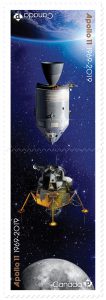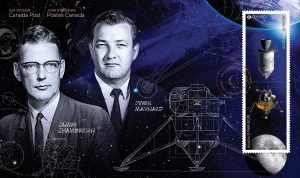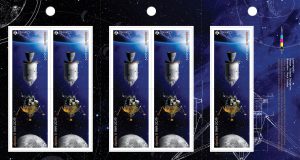By Jesse Robitaille
A pair of commemorative stamps recently issued by Canada Post to mark the 50th anniversary of the Apollo 11 mission also celebrates the Canadians who helped make the historic spaceflight and lunar landing possible.
Released nationwide on June 27, the stamps – available in booklets of 10 and panes of six – honour the significant Canadian contributions to the mission that landed the first two humans on the Moon.
“We’re used to seeing the Apollo 11 mission through 50-year-old lenses – grainy photos and blurry images,” said stamp designer Matthew Clark, of Vancouver’s Subplot Design. “We wanted to show what it would look like if those photos were retaken with the clarity of today’s cameras.”

The upper stamp of each tête-bêche pair, with Earth at the top, depicts the command and service module while the lower stamp shows the lunar module descending toward the moon.
While the stamps depict the Apollo 11 command module Columbia and lunar module Eagle, the latter of which was partly built by a company based in Longueuil, Qué., an official first-day cover (OFDC) features two Canadian engineers who were working at the National Aeronautics and Space Administration (NASA) at the time of the mission.
The realistic illustrations were produced by concept artist Mack Sztaba, of Toronto, who has also worked with Disney and Netflix as an illustrator and character and costume designer on big-budget films and TV shows.
“I mostly illustrate in the realms of science-fiction and fantasy,” said Sztaba, who added his biggest challenge was accuracy. “I’ve never done an illustration that had to be so precise.”
Assisting Clark and Sztaba were astronomy experts Chris Gainor, president of the Royal Astronomical Society of Canada (RASC), and Randy Attwood, publisher of SkyNews magazine and executive director of RASC.
They “checked every antenna, seam and hatch of the modules for authenticity,” according to Canada Post’s Details magazine.
A resident of Sidney, B.C., Gainor was in Mississauga this June for The Royal Philatelic Society of Canada (RPSC) Convention, which was held a week after the 2019 RASC Convention in nearby Toronto.
“Canada Post contacted me, and I was thrilled they were doing an Apollo 11 stamp,” said Gainor, who, in addition to serving as the president of RASC since last July, has collected stamps for more than 50 years.
“I started as a kid, and I have a variety of collections; my big one is a space collection with lots of stamps and covers.”
There are two main aspects to Canada’s role in the Apollo 11 mission, Gainor said.
“One part is the Avro folks, and actually some other Canadians who went down to work for the U.S. space program in the 1960s, and the other part is the physical one: most of the legs – but not the entire assembly – were made in Longueuil.”
CHAMBERLIN & MAYNARD
About a dozen Canadians had “leading roles” in the mission, Gainor said, adding James Chamberlin (1915-81), of Kamloops, B.C., and Owen Maynard (1924-2000), of Sarnia, Ont., are among the key figures honoured by Canada Post.
Chamberlin was a leading figure in aircraft design in Canada before moving to the U.S. to work for NASA in 1959. He became head of engineering for Project Mercury, the first U.S. human spaceflight program, and project manager and chief designer for the Gemini spacecraft, which preceded Apollo.
For the Apollo 11 mission, he helped determine the best type of spacecraft to transport the astronauts and was one of the first people at NASA to recognize flying directly to the Moon wasn’t an ideal option.
“He played a really important role in getting NASA to decide how to do the Apollo mission,” said Gainor, who added “there were a number of ways to do it.”
Instead, Chamberlin favoured having a smaller landing module travel to lunar orbit attached to the main spacecraft, then descend to the moon’s surface and later reconnect with the main spacecraft. This approach, known as lunar orbit rendezvous, became fundamental to the Apollo program.
Another one of Canada’s top aircraft engineers before being hired by NASA in 1959, Maynard went on to head the systems engineering division for the Apollo spacecraft program – effectively making him the chief engineer. He sketched early designs of the main Apollo command module and is credited as the person at NASA most responsible for the design of the lunar lander. He also served as chief of the mission operations division and was responsible for planning the sequence of missions leading to Apollo 11.
“Maynard was probably the highest-ranking Canadian in the management in the Apollo program,” said Gainor.
“His job was making sure all these different parts and systems worked together because the command and service module was built by one contractor and the lunar module by someone else. You had to get them – and all the systems inside of them – to work together and mesh with the control and communication systems.”
As for the new issue’s design, Gainor said Clark, Sztaba and the rest of the team “did a really terrific job.”
“It’s hard to do a design on Apollo 11 that’s original, but I think this is about as close as you can get. To be personally involved in a stamp like this is really exciting for me.”
Although Gainor has maintained several collections, the last RPSC Convention he attended was in July 1972 in Edmonton, Alta.
“I never stopped collecting; it’s just I just haven’t been active or organized.”
HÉROUX-DEVTEK
On July 20, 1969, more than half a billion people around the world were transfixed by grainy black-and-white TV footage of U.S. astronaut Neil Armstrong taking humankind’s first steps on the moon.
But the first legs to stand on the moon didn’t belong to Armstrong; they were from Héroux Machine Parts Limited (now known as Héroux-Devtek) in Longueuil. The company manufactured the spider-like landing gear legs on the lunar module to NASA’s specifications. The legs were also part of the launch platform allowing Armstrong and Buzz Aldrin to lift off from the Moon and reconnect with the main command module. Those legs remain on the moon at the Apollo 11 landing site in an area known as the “Sea of Tranquility.”
The stamps, which were unveiled at Héroux-Devtek on 755 Thurber St., in Longueuil, were printed by Lowe-Martin in six-colour lithography with PVA gum and tagging along three sides plus additional blue tagging on the Moon and stars “as a design feature.”
A total of 7,000 OFDCs with Longueuil cancellations were also printed as part of the release.
For more information, visit canadapost.ca.



